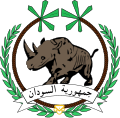Top Qs
Timeline
Chat
Perspective
List of heads of state of Sudan
From Wikipedia, the free encyclopedia
Remove ads
This article lists the heads of state of Sudan since the country's independence in 1956.
Remove ads
History of the office
Summarize
Perspective
Since independence was proclaimed on 1 January 1956, six individuals (and three multi-member sovereignty councils) have served as head of state of Sudan, currently under the title President of the Republic of Sudan. Prior to independence, Sudan was governed as a condominium by Egypt and the United Kingdom, under the name Anglo-Egyptian Sudan. As such, executive power was vested in a dyarchy consisting of both countries' heads of state – at the time of independence, the Queen of the United Kingdom (Elizabeth II) and the Egyptian Revolutionary Command Council (headed by Gamal Abdel Nasser). Immediately following independence, the role of head of state was filled by a five-member Sovereignty Council, with rival nationalist factions unable to agree on a single candidate. In November 1958, General Ibrahim Abboud led a military coup d'état, assuming the role of head of state as Chairman of the Supreme Council. Assuming the title of president in 1964, he resigned later that year due to general discontent around the rule of the military regime. Abboud was succeeded by a senior civil servant, Sirr Al-Khatim Al-Khalifa, who served as acting president for 18 days before transferring executive authority to a Committee of Sovereignty.
Ismail al-Azhari, the leader of the National Unionist Party, was made president in July 1965; he ruled with limited power until he was deposed in a 1969 military coup. The military officers responsible for the coup established the National Revolutionary Command Council, chaired by Jaafar Nimeiry. Nimeiry, the leader of the newly formed Sudanese Socialist Union, assumed the position of president in 1971, and subsequently established a one-party state, which existed until 1985, when a group of military officers overthrew his government and established the 1985 Transitional Military Council, led by Field Marshal Abdel Rahman Swar al-Dahab. Ahmed al-Mirghani succeeded to the relatively powerless position of Chairman of the Supreme Council in 1986, after multi-party election held that year. He was deposed in a 1989 military coup led by Lieutenant-General Omar al-Bashir. Al-Bashir served as head of state, under the title of Chairman of the Revolutionary Command Council for National Salvation from 1989 to 1993 and as president from 1993 to 2019 (and from 1996 as the leader of the National Congress Party).
Al-Bashir was removed from power by the Sudanese Armed Forces on 11 April 2019, amid the Sudanese revolution after holding the office for nearly 30 years. Lieutenant-General Ahmed Awad Ibn Auf took control of Sudan without becoming head of state, established the 2019 Transitional Military Council, but resigned the following day in favor of Lieutenant-General Abdel Fattah al-Burhan.[3] The Transitional Military Council was replaced with the Transitional Sovereignty Council on 21 August 2019, under the chairmanship of al-Burhan.[4] The Sovereignty Council, an 11-member civilian-military collective head of state, is designed to lead the country for 39 months in the transition to democracy, which is supposed to end with the next general election.[5] The Transitional Sovereignty Council was dissolved by al-Burhan on 25 October 2021, following a coup d'état.[6] Al-Burhan reinstated it on 11 November 2021, with some members replaced.[7][8][9]
Remove ads
Term limits
As of 2021, there is a two-term limit for the president in the Constitution of Sudan. The term limit has not been met by any president yet.[10]
Titles of heads of state
- 1956–1958: Sovereignty Council
- 1958–1964: Chairman of the Supreme Council
- 1964 : President
- 1964–1965: Committees of Sovereignty
- 1965–1969: Chairman of the Sovereignty Council
- 1969–1971: Chairman of the National Revolutionary Command Council
- 1971–1985: President
- 1985 : Commander-in-Chief
- 1985–1986: Chairman of the Transitional Military Council
- 1986–1989: Chairman of the Supreme Council
- 1989–1993: Chairman of the Revolutionary Command Council for National Salvation
- 1993–2019: President
- 2019 : Chairman of the Transitional Military Council
- 2019–2021: Transitional Sovereignty Council
- 2021 : Commander-in-Chief of the Armed Forces[11]
- 2021–present: Transitional Sovereignty Council
Heads of state of Sudan (1956–present)
Summarize
Perspective
(Dates in italics indicate de facto continuation of office)
Remove ads
Timeline

Incoming election
Notes
- Briefly interrupted during the 19–22 July 1971 coup d'état.
- Handed over power to the civilian government after the 1986 parliamentary election.
- Serving with Hemedti, Yasser al-Atta, Shams al-Din Khabbashi, Ibrahim Jabir Karim, Aisha Musa el-Said, Siddiq Tawer, Mohamed al-Faki, Hassan Sheikh Idris, Mohammed Hassan al-Ta'ishi and Raja Nicola.
- Serving with Deputy Chairman Hemedti (until 2023), Malik Agar (Deputy Chairman from 2023), Shams al-Din Khabbashi, Yasser al-Atta, Ibrahim Jabir Karim, El Hadi Idris Yahya, El Tahrir Abubakr Hajar, Raja Nicola, Abdulgasim Bortom, Yousef Jad Karim, Abdelbagi al-Zubeir, Salma Abdeljabbar.[7][12][13]
Remove ads
See also
References
External links
Wikiwand - on
Seamless Wikipedia browsing. On steroids.
Remove ads













